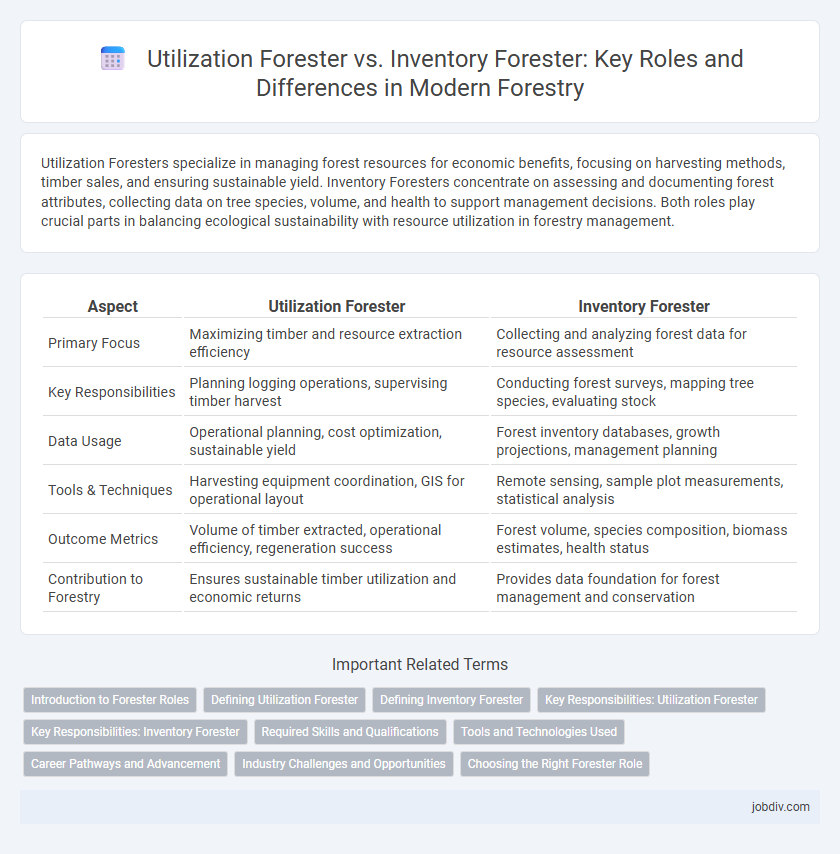Utilization Foresters specialize in managing forest resources for economic benefits, focusing on harvesting methods, timber sales, and ensuring sustainable yield. Inventory Foresters concentrate on assessing and documenting forest attributes, collecting data on tree species, volume, and health to support management decisions. Both roles play crucial parts in balancing ecological sustainability with resource utilization in forestry management.
Table of Comparison
| Aspect | Utilization Forester | Inventory Forester |
|---|---|---|
| Primary Focus | Maximizing timber and resource extraction efficiency | Collecting and analyzing forest data for resource assessment |
| Key Responsibilities | Planning logging operations, supervising timber harvest | Conducting forest surveys, mapping tree species, evaluating stock |
| Data Usage | Operational planning, cost optimization, sustainable yield | Forest inventory databases, growth projections, management planning |
| Tools & Techniques | Harvesting equipment coordination, GIS for operational layout | Remote sensing, sample plot measurements, statistical analysis |
| Outcome Metrics | Volume of timber extracted, operational efficiency, regeneration success | Forest volume, species composition, biomass estimates, health status |
| Contribution to Forestry | Ensures sustainable timber utilization and economic returns | Provides data foundation for forest management and conservation |
Introduction to Forester Roles
Utilization Foresters focus on maximizing the economic value of forest resources through sustainable harvesting and timber processing techniques, ensuring efficient resource use and minimal environmental impact. Inventory Foresters specialize in assessing forest composition, health, and growth by conducting detailed surveys and data collection to inform management decisions. Both roles are essential for balanced forest management, combining resource utilization with accurate monitoring and conservation practices.
Defining Utilization Forester
Utilization Foresters specialize in maximizing the economic value of forest resources by managing harvesting techniques, timber processing, and wood product optimization. They analyze forest stands to determine the most efficient use of available timber while minimizing waste and environmental impact. Unlike Inventory Foresters, who focus on measuring and assessing forest resource quantities, Utilization Foresters prioritize operational planning and sustainable extraction methods.
Defining Inventory Forester
An inventory forester specializes in assessing forest resources through systematic data collection and analysis to estimate timber volume, species composition, and forest health. Their role is critical for sustainable forest management by providing accurate information for planning harvests, monitoring growth, and evaluating ecological conditions. Unlike utilization foresters who focus on timber extraction methods, inventory foresters concentrate on quantifying and tracking forest assets to guide long-term stewardship.
Key Responsibilities: Utilization Forester
Utilization Foresters focus on maximizing the economic value of timber resources by overseeing harvesting operations, ensuring sustainable yield, and optimizing wood product quality. They coordinate with logging crews, monitor adherence to environmental regulations, and analyze market demand to guide timber extraction efficiently. Their key responsibilities include planning harvest schedules, evaluating tree species for best use, and implementing waste reduction strategies to enhance forest product profitability.
Key Responsibilities: Inventory Forester
Inventory Foresters specialize in assessing forest resources by conducting systematic data collection on tree species, size, health, and volume to create accurate forest inventories. They analyze stand dynamics and growth trends using advanced tools like remote sensing and GIS technology to inform sustainable forest management decisions. Their key responsibilities include generating detailed reports on forest composition and biomass for resource planning, conservation efforts, and timber valuation.
Required Skills and Qualifications
Utilization foresters require strong knowledge of wood product markets, harvesting techniques, and sustainable resource management to maximize timber value while minimizing environmental impact. Inventory foresters must excel in data collection, statistical analysis, and GIS technology to accurately assess forest resources and support management decisions. Both roles demand a bachelor's degree in forestry or related fields, proficiency in forest mensuration, and the ability to work in field conditions.
Tools and Technologies Used
Utilization Foresters employ tools like GPS mapping, timber cruising software, and laser measuring devices to assess and manage forest resources efficiently, focusing on harvesting and operational planning. Inventory Foresters utilize advanced technologies such as LiDAR, remote sensing, and GIS for comprehensive forest data collection, inventory analysis, and monitoring ecosystem health. Both roles integrate drones and handheld data collectors to enhance precision, but Utilization Foresters prioritize operational software while Inventory Foresters focus on analytical and statistical tools for resource assessment.
Career Pathways and Advancement
Utilization foresters specialize in maximizing the value of forest resources by overseeing timber harvesting and processing, often advancing to roles in resource management or consulting firms. Inventory foresters focus on assessing forest stands through data collection and analysis, with career growth leading to positions in forest planning, GIS analysis, or research. Both pathways offer opportunities to influence sustainable forest management and can converge in senior management or policy-making roles within forestry organizations.
Industry Challenges and Opportunities
Utilization foresters face challenges in optimizing timber harvest efficiency while ensuring sustainable resource management, balancing market demand with environmental regulations. Inventory foresters confront difficulties in accurate forest resource assessment, relying on advanced remote sensing and data analytics to improve stock monitoring and long-term planning. Both roles present opportunities to integrate technology and promote sustainable forestry practices that align with industry goals and conservation efforts.
Choosing the Right Forester Role
Choosing the right forester role depends on project goals, as utilization foresters specialize in optimizing timber harvest and resource extraction, while inventory foresters focus on assessing forest composition, health, and growth patterns through detailed data collection. Utilization foresters prioritize operational efficiency and market demands, applying knowledge of wood quality, harvesting methods, and logistics to maximize yield. Inventory foresters provide critical data for management decisions by conducting forest surveys, mapping, and monitoring ecological conditions, enabling sustainable planning and conservation efforts.
Utilization Forester vs Inventory Forester Infographic

 jobdiv.com
jobdiv.com